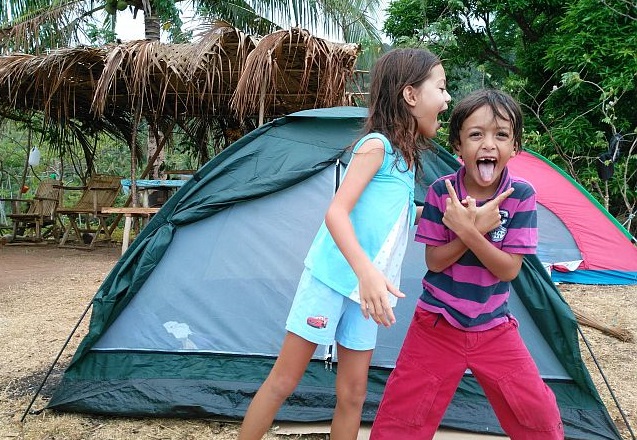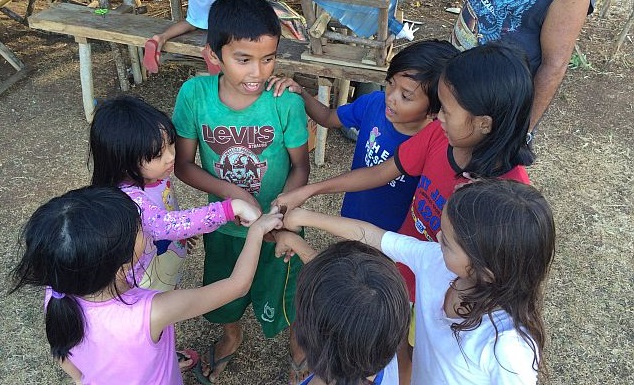How to teach kids to appreciate the rural life

Fraternal twins Sophie and Benjamin goof around at their campsite in Camiguin. (CDN PHOTO/ FRAULINE SINSON)
When classes start tomorrow, six schoolchildren will have quite a story to tell their classmates: a four-day camping trip in the mountains of Camiguin.
The six campers were divided into two groups. One group had siblings – twins Sophie and Benjamin Harmel, 7, and their younger sister Sarah, then 5.
They are Filipino-French who can understand a little bit of Bisaya. The other group was composed of cousins – my daughter SeM, 6; Maxy, then 6, my sister-in-law’s daughter; and Isla, 5, my brother’s daughter.
There are three ways to get to Camiguin from Cebu. One is by air through daily early morning flights. There are two options when you go by sea and land.
The longer route involves an overnight boat trip from Cebu to Cagayan de Oro City, a van then a bus ride from the airport to Balingoan port, and finally a ferry ride to Benoni port in Camiguin. The shorter and less expensive route, which we took, is a ferry ride from Cebu City to Tubigon, Bohol, a v-hire ride to Jagna port then a ferry ride from Jagna to Camiguin. A one-way trip costs about P900 each.
Sophie, Ben, Sarah and SeM all go to the same Montessori school in Cebu City while Isla goes to a different one in Mandaue. Maxy, on the other hand, had studied in Cavite. Standing as guardians for the trip were me, my husband, my father and my husband’s 17-year-old nephew.
The Harmel siblings quickly made friends with SeM’s cousins during the commute. One of the kids, Sarah, was lucky enough to spot a dolphin jumping just a few minutes after we left the Jagna port. Their energy seemed boundless as they ran around the ferry’s cramped space shrieking with laughter.
We spent the first night in Camiguin at a guesthouse because it was too late to go up the mountain. The rest of the kids were old enough not to be bothered by the fact that their parents weren’t with them. But it was different with the youngest of the group, Isla.
She cried herself to sleep for the first two nights. Eventually, she proved herself to be one tough cookie as she started sleeping soundly at night for the rest of the camping trip.
CAMPSITE
Our campsite was somewhere in the mountains of Mabago. We stayed with my father’s friend, 72-year-old Sernito Babanto, Lolo Serning as he is fondly called.
Because we are city slickers, we had our bags transported ahead by a couple of horses, costing us P250 per horse. We were accompanied by several local children during the more than 90-minute trek to the campsite and they helped us carry our water bottles because we were that exhausted.
We were sweating buckets as the summer sun shone unmercifully hot. At several points, the kids complained about the heat, some got scared of the insects and even of the dead green snake they found among empty coconut husks. All of them expressed disgust over the horses’ poop along the pathway, and a few trembled as we passed by deep ravines.

Camiguin kids teach young campers how to play local games. (CDN PHOTO/ FRAULINE SINSON)
EXPOSURE
The goals of the trip were to expose the iPad-savvy kids to life in the mountains, to make them appreciate what they have in the city, to learn local games and to get them to taste local snacks. Their parents were confident that their kids would be able to cope and learn from this unique experience.
And so we had the kids eat their meals using banana leaves as their plates. They slept in tents. They took a bath in a comfort room that was home to hundreds of black ants and occasionally visited by a 10-inch long gecko.
For fun, the kids chased Lolo Serning’s poor, defenseless native chickens. They collected the feathers of molting roosters. They fed leaves to the goats. Much to our consternation, they also tried to touch the horses even though they’d been warned not to do so because the horses might kick them.
They also flew kites made by Lolo Serning out of plastic grocery bags as the ones we brought and bought from Manalili were a total disaster.
For local flavor, the kids had a chance to see a dead six-foot long snake that had been killed by a neighboring farmer. The snake had been terrorizing the farmer’s chickens and had already fed on three of his hens.
The kids visited and paid their respects to neighbors located even higher up the mountain and more than a kilometer away. They also gorged themselves on champorado (chocolate porridge), budbod and coconut juice.
For skills-building, Lolo Serning taught the kids to weave coconut leaves that were used to make the roof of their tree house that overlooked Mantigue Island and where the kids spent most of their playtime. Arnis sessions, courtesy of my father, were done in the middle of a dried-up rice paddy.
My nephew Kurt, served as scout master and taught them how to tell which way was north, south, east and west. He also taught them how to tie different knots.
For socializing, they mingled with local kids who taught them games like hiding their dusty slippers to slapping palms and chanting songs where you have to tell the first letter of your sweetheart.
The local kids made an effort to communicate with them in English but eventually reverted to Bisaya that sometimes put the Harmel siblings into a daze.
EXPENSIVE WATER
Camping can be quite expensive when one insists on city conveniences.
There was no running water at the campsite so we had to have someone bring us water. One container of natural spring water cost P20 and our group of six kids and four adults used at least 10 containers per day. This was just water for bathing, for the toilet and for initial washing of dishes.
Drinking water from the refilling station cost P95 per 5-gallon bottle – P45 for the refilled water itself and P50 fee for the transport up the mountain. We consumed two 5-gallon bottles a day for drinking and cooking.
Fortunately, there is electricity at our part of the mountain so we were able to use our electric kettle to make hot water for coffee and chocolate drinks.
Cooking in a dirty kitchen involved a lot of huffing and puffing on my part to get the fire going. Our meals had quite a “smoky” flavor to it.
When the time came for the kids to come down the mountain, they did it in less than 60 minutes involving lots of downhill running and playful sliding, all their initial fears forgotten. The kids definitely want to return next year.
Disclaimer: The comments uploaded on this site do not necessarily represent or reflect the views of management and owner of Cebudailynews. We reserve the right to exclude comments that we deem to be inconsistent with our editorial standards.
